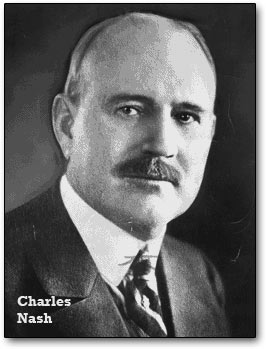Charles Nash (Charles Williams Nash)

Charles Nash was born to a poor farming family in Cortland, Illinois, on what is now Route 38 — Lincoln Highway. His mother was Anna E. “Annie” Cadwell (1829–1909) who married David L. Nash. Other Nash siblings included Mazovia (b. 1862), George C. (b. 1866) and Laura W. (b. 1868). After Charles’ parent’s separation, at age 6, Charles worked as a farm-hand in Michigan as an indentured servant under an agreement that was to last until he was 21. He had only three months of schooling per year while he was “bound out” to perform farm chores. At age 12, Nash ran away and became a farm hand first in Grand Blanc, Michigan for $8 per month, then for Alexander McFarland in Mount Morris, Michigan for $12 per month. On McFarland’s farm he learned the carpentry trade from John Shelben and formed the ‘Adams & Nash’ concern to press hay. While pressing hay on the Halleck farm, he met and married his future wife. On April 23, 1884, he married Jessie Halleck. Later, they then moved to Flint, Michigan, due to Jessie’s poor health. In 1890 where he was hired by William C. Durant of the Flint Road Cart Company which later became the Durant-Dort Carriage Company. Durant hired him in 1890 at a wage of $1 per day as an upholstery stuffer and within six months, he was promoted to superintendent of the factory. Within ten years, he was promoted to vice president and general manager of the Durant-Dort Carriage Company. Charles Nash introduced the straight-line belt conveyor into the assembly of carriages. In 1897, Nash had a chance to drive an early one-cylinder electric automobile, and became very interested in the commercial potential of this newly developed contraption.
By 1910, the chief business of Durant-Dort Carriage Company was building automobile bodies for Buick. Durant was the president of the new General Motors Corporation, but was overextended financially and in terms of management. Durant brought Nash over to Buick to take over production; Charles Nash became vice-president of Buick on 13 December 1910. In 1912, Nash hired Walter Chrysler from the American Locomotive Company to be the Buick Works Manager. In late 1912, Durant was fired by the GM board and Nash became president of General Motors. He focused on making GM a more efficient operation by liquidating unprofitable plants and streamlining manufacturing. He arranged for GM to purchase 51% of axlemaker Weston-Mott. Cost-cutting and higher sales were top priorities for the time frame. In three years time, he restored GM to organizational stability and financial good health. His strategy of consolidating into large units paid off: he combined three different truck operations into one and he merged several parts-making operations. Keen on building up an international market, he set up the General Motors Export Company to handle international sales. He moved the general offices from New York City to Detroit, created a new purchasing office, and set up their standardized accounting system and a new accounting office. However, his reluctance to pay dividends to shareholders resulted in Nash being forced out of GM in 1915 by Durant.
Charles Nash then resolved never again to work for someone else. He bought out the Jeffery Motor Company in Kenosha, Wisconsin, in August 1916 and in 1917, renamed it as Nash Motors. The 1917 Nash Model 671 was the first vehicle produced to bear the name of the new company’s founder. The new company was successful, with sales totaling 31,008 trucks and cars by 1919. In addition to running Nash Motors, Nash was also president of the luxury car company LaFayette Motors until that company was bought out by Nash Motors in 1924. By 1929, the Big Three, GM, Ford, and Chrysler controlled three fourths of the automobile market. Nash came next, producing 138,000 vehicles in 1928. He focused on producing one high-quality automobile for the upper medium price range, later adding a smaller model, the “Ajax”. He knew he could never compete with the Big Three in mass production of many different models, so he made his profits with careful management and close attention to costs, and opportunities for expansion. Nash was a hands-on executive, who concentrated on cutting costs, developing more efficient purchasing, and setting up accounting procedures that would specify the source of this costs and profits. He purchased numerous failed companies and incorporated them. In 1937 he merged his company with Kelvinator, a leading maker of refrigerators, to become the Nash-Kelvinator company. He gave up the presidency in 1932, but kept power in his own hands as chairman of the board. During World War II, Nash-Kelvinator temporarily stopped production of automobiles and consumer goods, and instead dramatically expanded with Pentagon contracts for aircraft engines, propellers, and other munitions. He retired in 1945 to California and died at the age of 84 in Beverly Hills, California.
Born
- January, 28, 1864
- USA
- Cortland, Illinois
Died
- June, 06, 1948
- USA
- Beverly Hills, California
Cemetery
- Forest Lawn Memorial Park (Glendale)
- Glendale, California
- USA


